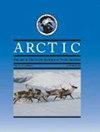Using Visual Observations to Compare the Behavior of Previously Immobilized and Non-Immobilized Wild Polar Bears
IF 0.8
4区 地球科学
Q4 ENVIRONMENTAL SCIENCES
引用次数: 1
Abstract
During 17 field seasons between 1973 and 1999, we conducted a long-term study of the behavior of undisturbed wild polar bears in Radstock Bay, southwest Devon Island, Nunavut. In a subset of 11 seasons (6 spring and 5 summer) between 1975 and 1997, we used three different drug combinations to chemically immobilize a small number of adult and subadult polar bears on an opportunistic basis and applied a temporary dye mark so that individual bears could be visually reidentified. We then used multinomial logistic regression to compare the behavior of 35 previously immobilized bears of five different demographic classes (sex, age, and reproductive status) to the behavior of non-immobilized bears of the same demographic classes in the same years and seasons. During the first two days after immobilization, bears slept significantly more and spent less time hunting than did bears that had not been immobilized. However, previously immobilized bears returned to the same behavioral patterns and proportion of total time spent hunting as non-immobilized bears within two days and no further negative behavioral effects were detected in the following 21 d. We visually confirmed successful hunting by three adult bears within 0.4 to 2.1 d of being immobilized, all of which went on to make additional kills within the following 24 h. The return to normal behavior patterns, including the ability to hunt successfully, within 48 h of immobilization appears consistent with the hypothesis that polar bears do not experience longer-term behavioral effects following brief chemical immobilization for conservation and management purposes.利用视觉观察比较先前固定和未固定的野生北极熊的行为
在1973年至1999年的17个野外季节中,我们对努纳武特德文岛西南部拉德斯托克湾未受干扰的野生北极熊的行为进行了长期研究。在1975年至1997年的11个季节(6个春季和5个夏季)中,我们使用了三种不同的药物组合,在机会性的基础上化学固定了少量成年和亚成年北极熊,并使用了临时染料标记,以便可以在视觉上重新识别单个熊。然后,我们使用多项逻辑回归将五个不同人口类别(性别、年龄和生殖状况)的35只先前固定的熊的行为与同一人口类别的非固定熊在同一年份和季节的行为进行了比较。在固定后的头两天,熊比没有固定的熊睡得更多,狩猎时间更少。然而,之前固定的熊在两天内恢复了与非固定的熊相同的行为模式和狩猎总时间比例,在接下来的21天内没有检测到进一步的负面行为影响,所有这些都在接下来的24小时内进行了额外的杀戮。在固定后48小时内恢复正常的行为模式,包括成功狩猎的能力,似乎与北极熊在出于保护和管理目的的短暂化学固定后不会经历长期行为影响的假设一致。
本文章由计算机程序翻译,如有差异,请以英文原文为准。
求助全文
约1分钟内获得全文
求助全文
来源期刊

Arctic
地学-环境科学
CiteScore
2.30
自引率
0.00%
发文量
51
审稿时长
6-12 weeks
期刊介绍:
Arctic is a peer-reviewed, primary research journal that publishes the results of scientific research
from all areas of Arctic scholarship. Original scholarly papers in the physical, social, and biological
sciences, humanities, engineering, and technology are included, as are book reviews,
commentaries, letters to the editor, and profiles of significant people, places, or events of northern
interest
 求助内容:
求助内容: 应助结果提醒方式:
应助结果提醒方式:


